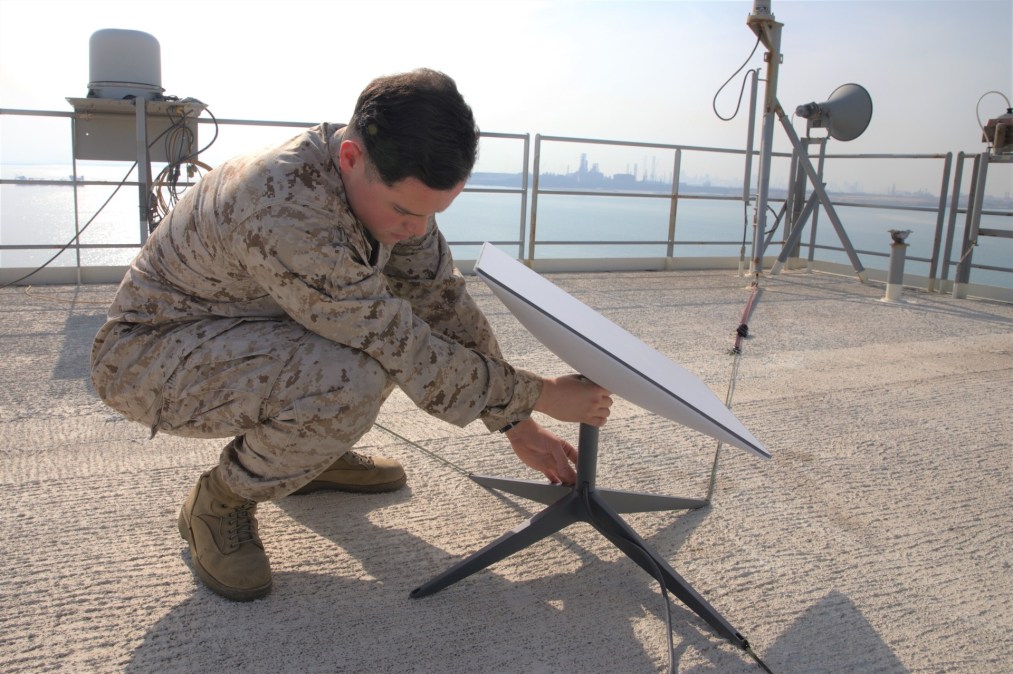Starlink terminals give Navy ‘game-changing’ flexibility

The Department of the Navy is evaluating SpaceX’s made-for-government Starshield/Starlink terminals on at least two deploying ships — with aims to field those broadband-providing capabilities across a fleet of up to 200 in the future.
Though the service declined to identify which vessels were equipped with the terminals or where they’re operating, two officials briefed DefenseScoop in a conversation over email regarding what they refer to as those “shipboard Navy Starlink efforts.”
All associated work falls under the Navy’s program of record for Proliferated low Earth orbit (P-LEO) within Naval Information Warfare Systems Command’s program executive office for command, control, communications, computers and intelligence and PEO Digital.
The efforts are referred to as Satellite Terminal (transportable) Non-Geostationary, or STtNG, and the Sailor Edge Afloat and Ashore (SEA2) pilot.
“I’ve seen first-hand the tremendous transformational capability that STtNG has brought to the Fleet. The small footprint, high bandwidth system allows the Fleet to download cybersecurity patches, send large files across the globe, and conduct critical Navy administrative functions faster than ever using a terminal the size of a pizza box,” Capt. Kristine De Soto, program manager for NAVWAR PEO C4I PMW/A 170, said.
While the service would not discuss recent or current on-ship deployments for security reasons, a May 2023 press release stated that in February of that year a “WiFi-enabled Starlink system was installed aboard USS Gerald R. Ford (CVN 78), allowing the crew that opportunity to quickly and easily communicate with their loved ones.”
Commercial satellite terminals can be quickly integrated with the Navy’s afloat, expeditionary and shore platforms, to supply satellite-internet capabilities that can enable sailors to see quicker performance improvements and connectivity.
Elon Musk’s company SpaceX has long been beaming broadband service to customers worldwide through its still-growing Starlink constellation — and in 2022, it unveiled Starshield, which is designed for use by the government and national security sector.
According to Genie Chaiken, principal assistant program manager within the Navy’s communications and GPS navigation office, Starlink capabilities provide “greater broadband internet access to sailors to increase warfighter operational readiness through shipboard systems, and use of personal devices over both military and non-military networks.”
“Starlink satellite service is game-changing technology available now that creates operational advantage by providing persistent, secure, global access to resilient, high-speed, low-latency, higher-bandwidth, and increased resiliency at sea to enable tangible warfighting impact,” she told DefenseScoop.
For the Navy, so far, specific impact areas span recruitment and retention, mental health, cloud services, and work stoppages due to slow and inaccessible websites, Chaiken noted. She and her team have observed in real-time how Starlink can help augment existing Naval programs of record that provide the primary communication pathways for ships.
“Feedback from ships: game-changer in terms of flexibility, additional bandwidth and ease of use,” she wrote in an email — adding that it’s all part of the sea service’s aim to embrace “new concepts that ensure we can rapidly adapt to the needs of the future.”
The Navy has decades of experience transmitting communications via satellite, and now Starlink provides another tool for the fleet.
“Simply put, PLEO is an additional transport path,” Chaiken said.
With the proliferation of low-Earth orbit systems such as Starlink, the military now has more — and in some cases, cheaper — options to provide communications coverage and data to personnel abroad.
They also enable greater resiliency and diversity in communications pathways, something the military has been pursuing as it expects to operate in contested environments where certain accesses might either not be available or jammed by the enemy.
These LEO systems, which orbit at altitudes of 1,200 miles or less, require smaller terminals than geosynchronous orbit systems, which orbit at over 22,000 miles above Earth, providing the Navy with the ability to place them on all ship classes for higher throughput than ever before.
These new technologies also enable forces to operate in a more dispersed manner — something that is expected against sophisticated adversaries across vast distances in the Pacific — while still maintaining connectivity.
Navy officials said the Starlink capability will contribute to and enable its distributed maritime operations concept.
The tech will support a global Navy presence through modernized, flexible and durable networks aligned to Joint All-Domain Command and Control priorities, the two officials said, referring to the Pentagon’s vision for how systems across the entire battlespace from all military services and key international partners could be more effectively and holistically connected to provide the right data to commanders for better and faster decision-making.
It will also provide greater broadband internet access and ubiquitous coverage to enhance joint operations with other services, allies and partners.
How the terminals are used depends on the needs of the ships where they are deployed, but they can support a wide range of maritime operations.
“STtNG demonstrated successful shipboard performance in FY22 and moved to full fielding. Both STtNG and SEA2 field Starlink based on Fleet demand for up to 200 ships based on the current design. STtNG combined with SEA2, provided users with significant performance improvements, including the ability to easily access distance learning and training courses, update social media pages, download cybersecurity patches, provide reach back for mission support contractors, and access large files stored in the cloud and medical and dental records,” Chaiken said.
She added: “STtNG demonstrated successful shipboard performance in FY22 and moved to full fielding. Again, all systems field based upon the needs of the fleet and budgets.”
Looking to the future, Chaiken and the PEO C4I team are looking forward to multiple competing constellations on the horizon, including Amazon Kuiper, One Web, and Telesat. Such capabilities will also enable more modernized, flexible and durable network options that align to Joint All-Domain Command and Control priorities.



